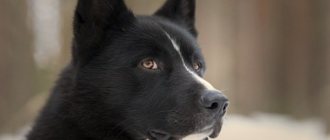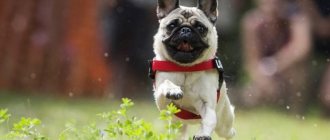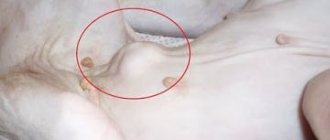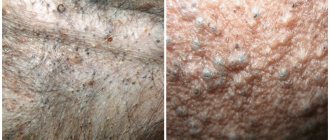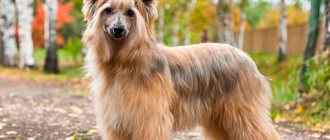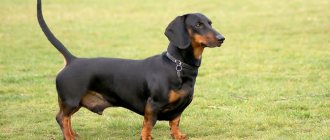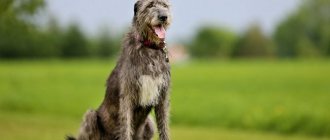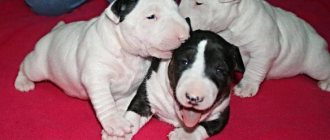Pugs are one of the most amazing dogs. A flattened face reminiscent of a monkey, a perky curved tail, a cheerful disposition and unwavering devotion - all this is about them.
Such data simply could not go unnoticed and our heroes often acted as favorites of kings and people in power. The history of the breed is shrouded in secrets and legends; it came to us from the east, from distant China. Today, pugs are still popular and in demand, and this is not at all surprising.
Story
The breed of dogs with a flat nose originated in China many centuries ago. It is likely that their ancestors were dogs of the Lo Ze breed. The external resemblance is almost complete, but in those days there were not so many folds on the animal’s forehead, but only a hint of them, visually reminiscent of an unreadable hieroglyph. Such a mark distinguished the lo dze from other imperial pets and created an aura of mystery around them. People always strive to get closer to what seems to them endowed with supernatural meaning, and this is what happened with the dogs that wore the sign of the emperor on their foreheads.
For a long time, pugs and their distant ancestors were privileged animals, which were in great demand among rich and influential people. Naturally, the standard of living to which animals are accustomed can, without exaggeration, be called royal. There is a version according to which Luo Ze were bred exclusively in the nurseries of His Imperial Majesty. As a result of inbreeding, a small mutation occurred, which was reflected in the appearance of the animal, or rather, in its non-standard shape of the muzzle, varieties of the skull, and multiple variants of the shape of the eyes and ears. Pugs have played many important roles in history.
Josephine's favorite acted as a postman. It was he who delivered ardent messages to the emperor and took the answer from his lover to his mistress.
Everyone knew that pugs were the favorites of Napoleon’s wife, and this did not work in the animals’ favor. After the crushing defeat of the commander, all those who wanted to take out their accumulated anger on the ruler, but did not have such an opportunity, were content with petty revenge against small dogs. So the animals were subjected to repression.
Gradually the breed began to disappear from the face of the earth. Interest in her faded until Queen Victoria came to the English throne. It was she who expressed a desire to get a pug as her companion. And then difficulties arose, since getting a dog of this breed turned out to be a difficult task; they were nowhere to be found. The difficult situation became the impetus for the revival of the breed. English breeders began with all their ardor to recreate the imperial favorites. The result of English scientists was not at all similar to those pets who live in our houses and apartments today. The dogs were tall, with an elongated nose and long ears. The experiments continued until a purebred puppy with all the necessary parameters was born.
Already in 1883, the first English club for pug lovers was formed. In 1885, inspections were held of those puppies that were selected as successful specimens, and this time the result was satisfactory. Since then, the fashion for pugs began to grow to the level of all European countries and spread to Russia. If you look at the portrait of Maria Fedorovna with her children, you will see our hero there too.
English Bulldog – 18-25 kg
The Bulldog is a gentle family companion, but was originally bred for the sport of bull baiting. This dog combines loyalty and determination, thanks to which the breed has gained popularity. Few breeds are as easily recognizable as the bulldog, with its wrinkled face and undershot jaws.
The personality and temperament of the breed are almost ideal. The Bulldog loves children and is very easy to train, and is considered an excellent family pet. He is an endless source of entertainment, very affectionate, and attracts attention wherever he goes. In general, the Bulldog is an easy breed. Even the laziest owner can handle his exercise needs, and he doesn't tend to be a picky eater. This breed has a short coat that does not require much grooming, although there are some skin care needs. Last but not least, bulldogs need comfort and good air conditioning. This is not a breed that can or should live outdoors.
Description of the breed
Pugs have always been human companions and today perform the same task. Their body is compact, but muscular and strong. They are active, playful and easy-going. It’s not for nothing that pugs are talked about briefly, but for sure – a lot in a little.
Today the following established standards apply:
- The head is round, but not spherical.
- The tail is carried high, usually curled into two rings, but one ring pressed to the back is also allowed.
- Black button nose.
- The eyes are slightly protruding, round and large. The iris is usually brown.
- The ears are triangular in shape, small in size, and erect.
- The body is square, strong, muscular.
- The limbs are long in proportion to the body and straight.
- The teeth are straight, but a slight inclination of the lower incisors is allowed.
Acceptable standard pug colors are easy to remember. The Chinese described them with their characteristic oriental romance:
- Warm sun (apricot and light beige),
- Shiny Moon (silver),
- Darkness of the night (black).
It is interesting that for a long time the black color was considered a defect and did not participate in the continuation of the species.
Irish Red Setter
Like other representatives of the “setter quartet”, it belongs to the family of cops. The peculiarity of the Irish Red is its rich, monochromatic coat color. He has a lean build, weighs up to 34 kg, and is up to 66 cm tall.
A breed originally intended for hunting. He “calculates” the game easily, sneaks after it like a cat, crouching to the ground so that the prey does not fly away. It can remain silent for a long time if it is hunting. Gets along well with the owner, does not like other dogs. He doesn't make a watchman; he's too sociable and friendly. A very smart breed.
Needs daily hour-long runs (better even more), loves to take long walks outside. If he is in the mood, he follows commands. The setter needs to be constantly trained, both physically and mentally. If this is not done, he will turn into a wayward and disobedient dog. At the same time, it is completely undesirable to use force, then the setter will be neither good-natured nor obedient. If a dog is playing with a child, it is best to keep an eye on them. When they see a bird or a rodent, the hunter in them wakes up.
Careful care is required. Firstly, regular brushing. Secondly, protection from dirt with a special overall, since too frequent washing harms the natural lubrication of the skin. In addition, it is necessary to regularly clean the dog’s ears (at least once a week), since otitis media often occurs in representatives of the breed. Eyes are cleaned as needed. They should be fed only with special food; in addition, setters drink a lot. You should have a supply of water while walking.
Character
The character of pugs is perfectly adapted to people. Moreover, families with children, single elderly people, and single young people who prefer an active lifestyle can act as hosts.
The only thing a dog constantly needs is the attention of its owner. Pugs are very sociable and affectionate. In order to become their owner, you do not need to have a whole set of knowledge and skills; even a twelve-year-old child can do it. As for training, everything here is extremely simple.
Animals are endowed with a high level of intelligence and good memory; they understand everything quickly and remember for a long time.
Pugs are very active and playful, especially when they are puppies. Over time, they acquire nobility, a status quality acquired over centuries. If you hear someone complaining about the quarrelsome nature of a pug, then know that the fault is not with the dog, but with its owner. In order for an animal to develop correctly, it is necessary to promote its socialization. For pet owners, there are group classes that teach all the basics needed in the future.
Pekingese
A breed considered sacred in Ancient China. It is suitable for an inexperienced breeder, but families with small children should not take the dog, as the child can injure the animal.
Pekingese puppies are almost impossible to train due to their stubborn nature. The dog barks often, and for no apparent reason. This feature is also worth considering, especially if you decide to get a Pekingese puppy in an ordinary city apartment.
The advantages of the breed are longevity and cleanliness. Difficulties include caring for the coat and difficulty getting along with family members and other animals.
Features of maintenance and care
The first problem you will encounter is finding ammunition. Such a task may arise before you if you are going on a trip with your pet, for example.
The anatomical features of the animal do not allow putting a regular collar on it, since the neck is almost the same thickness as the head.
A harness with a cross on the chest can help you. Well, finding a muzzle for a pug is generally a task from the realm of science fiction.
Of course we are talking about an apartment dog. To teach a puppy to relieve itself outside, it must be taken for a walk up to six times a day. It is enough to walk an adult pet twice a day. Their coat is short and does not require special care. But the folds on the dog’s face need constant attention. They must always be clean and dry. If you notice that there is a rash in the folds, do not delay visiting the veterinarian. The nose, ears and teeth are also subject to constant cleaning and monitoring.
Pugs are afraid of drafts and are prone to colds. They also do not tolerate heat well. From all this it follows that you will have to worry about a wardrobe for your pet. As surprising as it sounds, your pet will also wear shoes, especially in inclement weather.
The breed is prone to allergic reactions, so the diet should be prepared with caution. It is best to give preference to premium food, developed specifically for this species. For those who prefer natural nutrition to dry food, remember that the diet should be based on meat, grains, offal, vegetables, fruits and oils. Be careful about obesity. In the case of pugs, this is a real disease that leads to a deterioration in the quality of life and a shortened lifespan. On average, with proper care, they can live up to fifteen years.
Who are brachycephalics
All breeds whose representatives have a modified skull structure as a result of artificial selection are called brachycephalic. The muzzle of such creatures is shortened, flattened, and flat. Such dogs suffer from physiological problems related to breathing. Their nostrils are too narrow, the palate, trachea and tear ducts are compressed.
Brachiocephalic dogs are afraid of heat and exercise.
The owner must closely monitor the condition of such an animal; fainting and complications are possible out of the blue. They do not like collars, as these devices put too much pressure on the trachea.
Brachycephalic respiratory syndrome
Price
If you study the advertisement on the Internet, you will come across those where they are ready to sell you a puppy for three thousand rubles and those where we are talking about ninety thousand rubles.
This range in prices is due to various factors, including the purity of the breed, the availability of documents, the pedigree of the dog, and much more.
In order not to risk stumbling upon a sick animal or an obvious mixed breed, the origin of which is not visible for the first months of its life, always contact an experienced and reputable breeder at the nursery.
Shar Pei
A dog distinguished from other breeds by a large number of skin folds. Shar Peis have a sense of self-esteem and do not bother the owner with the need for careful grooming. The only thing that the owner should take into account is the dog’s need for long and frequent walks to maintain its muscle corset.
The pet is squeamish about water, and therefore it is not worth bathing it often.
The characteristics of the breed are:
- Balanced character.
- Loyalty to the owner.
- Security qualities.
- Cleanliness.
Dog experts call willfulness of character, aggression towards other animals, and health problems in the form of allergic reactions as disadvantages.
Are there any special health concerns for brachycephalic dogs?
While not all such dogs develop health problems, the shape of a brachycephalic dog's nose and head puts them at risk of developing what is called brachycephalic syndrome. Dr. Cheryl Yuill of Veterinary Centers of America says so. There are four main upper respiratory tract pathologies that can cause this condition, and a dog may have one or more of these pathologies.
These include:
- Stenosis (narrowing) of the nostrils. Small or narrow nostrils, which may restrict airflow when breathing through the nose.
- Elongated soft palate (soft palate hyperplasia). The soft palate—a fold of mucous membrane on the upper surface of the mouth—is too long and extends to the back of the throat, causing blockage of the trachea.
- Tracheal collapse. The windpipe or trachea is narrower in diameter than normal.
- Eversion of the laryngeal sacs. Laryngeal pouches are outgrowths of the mucous membrane located directly inside the dog’s larynx. They may roll over or turn outward if the dog struggles to breathe through narrowed nostrils or an elongated soft palate. Although this pathology is usually caused by one of the disorders described above, it can lead to additional obstruction of the animal's airways.
Dogs suffering from this syndrome usually snore loudly and pant loudly. They may experience increased gagging or be prone to reverse sneezing or tracheal collapse. The gums or tongue can sometimes turn blue from lack of oxygen, and overexertion or overexcitement can lead to respiratory failure. Due to difficulty breathing, these dogs tend to have trouble with vigorous exercise and are more susceptible to overheating and heatstroke than others.
Because these conditions and their symptoms are exacerbated by obesity, treatment for overweight animals with brachyphalic syndrome is usually supplemented with a diet to reduce weight. Mild cases can usually be controlled by monitoring the dog's weight and exercise level, avoiding exposing him to excess heat and moisture, and reducing or avoiding stress. For short-term treatment of exacerbations that cause respiratory distress syndrome (breathing failure), veterinarians may prescribe corticosteroids to reduce inflammation and/or oxygenation in a hospital setting (“oxygen treatment”). In more severe cases, surgery may be required to improve the passage of air into the lungs.
conclusions
This study confirms that the brachycephalic skull shape, relatively large palpebral fissure, nasal fold, and visible sclera, often recommended by breed standards, are risk factors for the development of corneal ulcers. Breeders and buyers of predisposed breeds should select dogs with more moderate eye sizes, relatively longer muzzles, and less pronounced or preferably absent nasal folds to reduce the risk of this disease and avoid the need for surgery in their dogs. We recognize that the etiology of corneal ulcers is often multifactorial and complex, with variability even between dogs of the same breed; however, this only reinforces the need for a multipronged approach to reduce the prevalence of corneal ulcers in corneal-prone breeds. The results presented here suggest that to reduce the risk of developing corneal ulcers in dogs that exhibit any of the four predisposing characteristics described above, and especially a combination of them, they should be avoided as studs in breeding programs and should not be prize-winning dogs. at shows, and these characteristics should not be encouraged in breed standards.
Source: Impact of Facial Conformation on Canine Health: Corneal Ulceration Translation is abbreviated. Links to sources are provided in the original article.
See also:
- Gender differences in people's perception of dogs
- It's all in the mother's genes: a new discovery in hereditary eye diseases in dogs
- How to evaluate a dog's intelligence?
- Do dog breeds differ in pain sensitivity?
- Old dogs and new research
- Key Canine Genetic Innovation: Diet
- Is this dog really happy?
- The sad truth about dogs and depression
- To cut or not to cut: what do we know about the properties of fur and thermoregulation in dogs
- Dogs see the world differently than people
- 18
Shared - 16
- 2
Dalmatian – 15-32 kg
Unique spots are the Dalmatian's calling card, and his ability to win is what makes him famous. The Dalmatian is an intelligent dog with a sly sense of humor. He is a clown and will do anything to make you laugh. He also has an endless capacity for exercise. The Dalmatian loves to jog: don't be surprised if he sneaks into your dresser, pulls out some running shorts and brings them to you as a not-so-subtle hint. Its high level of mobility makes it an excellent companion for people who are active. The Dalmatian loves attention and has a strong desire to please, so it is not uncommon for him to win in dog sports. He also excels at performing various tricks. Being part of a family is important to this breed. He likes to be with his people and know everything that is going on.
Like most dogs, Dalmatians get bored when left alone. They can easily become noisy or destructive if they don't have other dogs to keep them company and people aren't able to give them the proper amount of attention. Last but not least, it goes without saying that a people-loving dog like the Dalmatian should live in the home.
